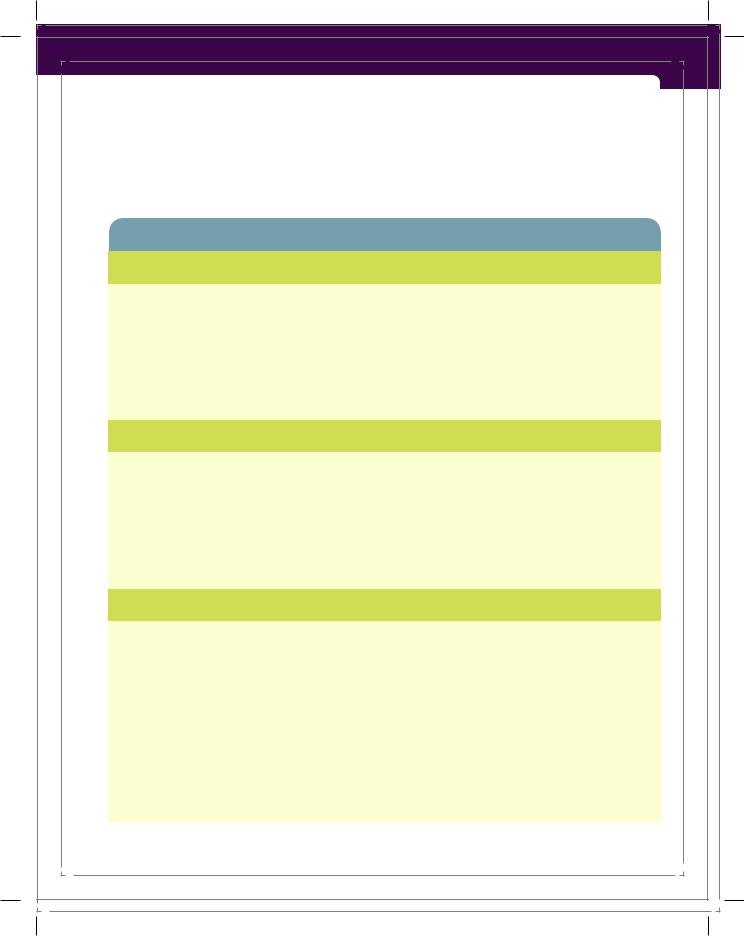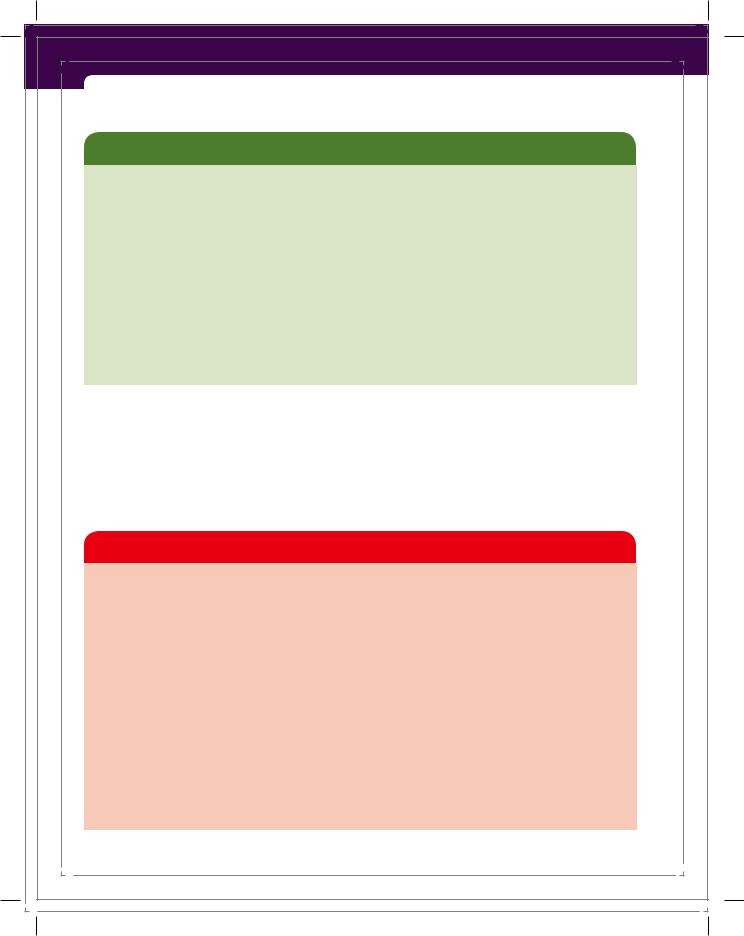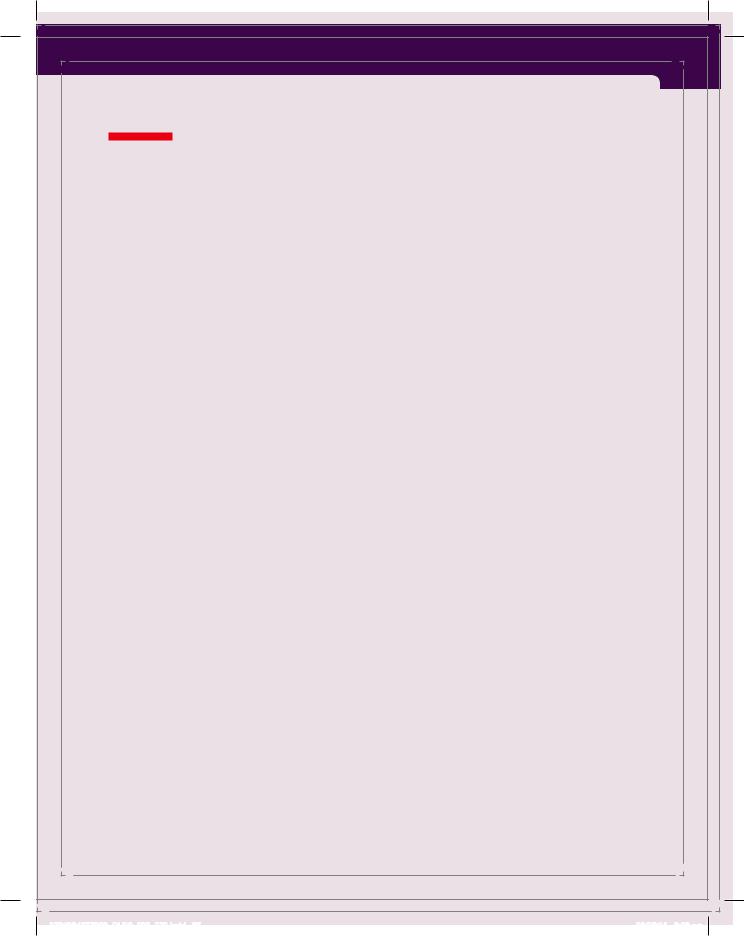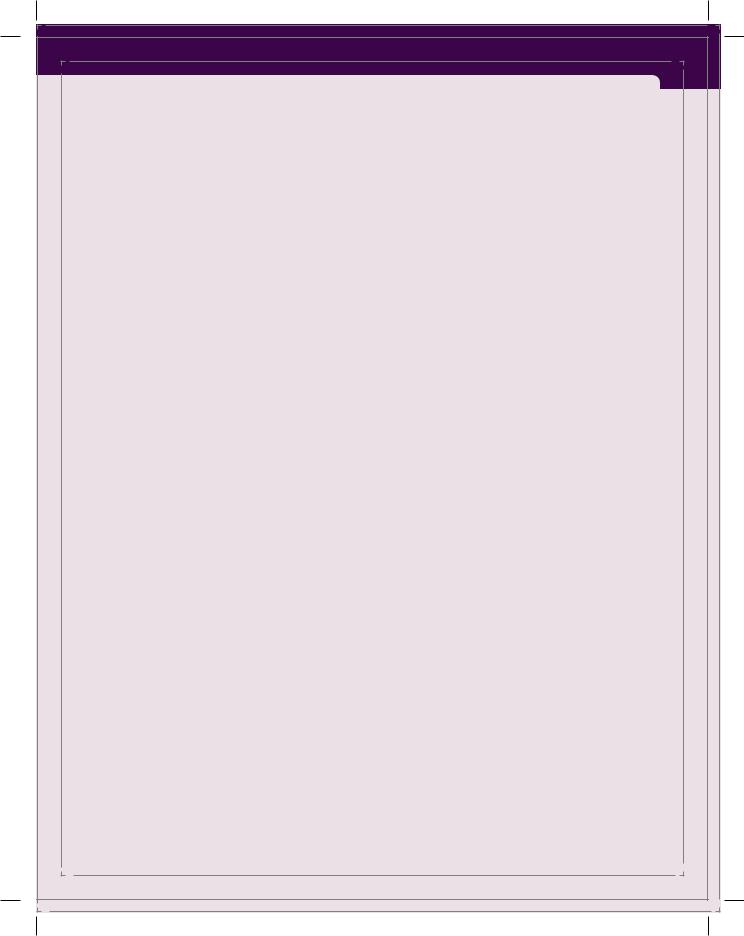
Introduction to Bioethics
.pdf
Introduction to Critical Thinking and Ethical Decision Making |
63 |
problems. Cases are analyzed according to four topics: “medical indications, patient preferences, quality of life, and contextual features” (Jonsen et al., 2010, p. 8). Nurses and other healthcare professionals on the team gather information in an attempt to answer the questions in each of the four boxes. The Four Topics
Table 2-1 Four Topics Method for Analysis of Clinical Ethics Cases
Medical Indications
The Principles of Beneficence and Nonmaleficence
1.What is the patient’s medical problem? Is the problem acute? Chronic? Critical? Reversible? Emergent? Terminal?
2.What are the goals of treatment?
3.In what circumstances are medical treatments not indicated?
4.What are the probabilities of success of various treatment options?
5.In sum, how can this patient be benefited by medical and nursing care, and how can harm be avoided?
Patient Preferences
The Principle of Respect for Autonomy
1.Has the patient been informed of benefits and risks, understood this information, and given consent?
2.Is the patient mentally capable and legally competent, and is there evidence of incapacity?
3.If mentally capable, what preferences about treatment is the patient stating?
4.If incapacitated, has the patient expressed prior preferences?
5.Who is the appropriate surrogate to make decisions for the incapacitated patient?
6.Is the patient unwilling or unable to cooperate with medical treatment? If so, why?
Quality of Life
The Principles of Beneficence and Nonmaleficence and Respect for Autonomy
1.What are the prospects, with or without treatment, for a return to normal life, and what physical, mental, and social deficits might the patient experience even if treatment succeeds?
2.On what grounds can anyone judge that some quality of life would be undesirable for a patient who cannot make or express such a judgment?
3.Are there biases that might prejudice the provider’s evaluation of the patient’s quality of life?
4.What ethical issues arise concerning improving or enhancing a patient’s quality of life?
5.Do quality-of-life assessments raise any questions regarding changes in treatment plans, such as forgoing life-sustaining treatment?
6.What are plans and rationale to forgo life-sustaining treatment?
7. What is the legal and ethical status of suicide? |
(continues) |
9781284077223_CH02_033_070.indd 63 |
09/03/15 8:06 pm |

64 |
Chapter 2 Introduction to Bioethics and Ethical Decision Making |
Table 2-1 Four Topics Method for Analysis of Clinical Ethics Cases (continued)
Contextual Features
The Principles of Justice and Fairness
1.Are there professional, interprofessional, or business interests that might create conflicts of interest in the clinical treatment of patients?
2.Are there parties other than clinicians and patients, such as family members, who have an interest in clinical decisions?
3.What are the limits imposed on patient confidentiality by the legitimate interests of third parties?
4.Are there financial factors that create conflicts of interest in clinical decisions?
5.Are there problems of allocation of scarce health resources that might affect clinical decisions?
6.Are there religious issues that might influence clinical decisions?
7.What are the legal issues that might affect clinical decisions?
8.Are there considerations of clinical research and education that might affect clinical decisions?
9.Are there issues of public health and safety that affect clinical decisions?
10.Are there conflicts of interest within institutions and organizations (e.g., hospitals) that may affect clinical decisions and patient welfare?
Source: Jonsen et al., 2010
Method facilitates dialogue between the patient–family/surrogate dyad and members of the healthcare ethics team or committee. By following the outline of the questions, healthcare providers are able to inspect and evaluate the full scope of the patient’s situation and the central ethical conflict. After the ethics team has gathered the facts of a case, an analysis is conducted. Each case is unique and should be considered as such, but the subject matter of particular situations often involves common threads with other ethically and legally accepted precedents, such as landmark cases that involved withdrawing or withholding treatment. Though each case analysis begins with facts, the four fundamental principles— autonomy, beneficence, nonmaleficence, and justice—along with the Four Topics Method are considered together as the process, and resolution take place (Jonsen et al., 2010). In Table 2-1, each box includes principles appropriate for each of the four topics. To see an analysis of a specific case, go to http://depts.washington
.edu/bioethx/tools/cecase.html.
Frustration, anger, and other intense emotional conflicts may occur among healthcare professionals or between healthcare professionals and the patient or the patient’s surrogates. Unpleasant verbal exchanges and hurt feelings can result. Openness and sensitivity toward other healthcare professionals, patients, and family members are essential behaviors for nurses during these times. As
9781284077223_CH02_033_070.indd 64 |
09/03/15 8:06 pm |

Introduction to Critical Thinking and Ethical Decision Making |
65 |
information is exchanged and conversations take place, nurses need to maintain an attitude of respect as a top priority. If respect and sensitivity are maintained, lines of communication more likely will remain open.
■■ The Healthcare Team
When patients and families are experiencing distress and suffering, it often is during times when decisions need to be made about risky procedures or end-of-life care. Family members may want medical treatment for their loved one, while physicians and nurses may be explaining to the family that to continue treatment most likely would be nonbeneficial or futile for the patient. When patients are weakened by disease and illness and family members are reacting to their loved one’s suffering, decisions regarding care and treatment become challenging for everyone concerned.
In caring for particular patients and interacting with their families, nurses sometimes find themselves caught in the middle of conflicts. Though nurses frequently make ethical decisions independently, they also act as an integral part of the larger team of decision makers. Many problematic bioethical decisions will not be made unilaterally—not by physicians, nurses, or any other single person. By participating in reflective dialogues with other professionals and healthcare personnel, nurses are often part of a larger team approach to ethical analysis. When a team is formally assembled and is composed of preselected members that come together regularly to discuss ethical issues within an organization, the team is called an ethics committee. An organization’s ethics committee usually consists of physicians, nurses, an on-staff chaplain, a social worker, a representative of the organization’s administrative staff, possibly a legal representative, local community representatives, and others drafted by the team. Also, the involved patient, the patient’s family, or a surrogate decision maker may meet with one or more committee members. See Box 2-7 for examples of the goals of an ethics committee.
Members of the healthcare team may question the decision-making capacity of the patient or family, and the patient’s or family’s decisions may conflict with the physician’s or healthcare team’s recommendations regarding treatment. Sometimes a genuine ethical dilemma arises in a patient’s care, difficult decisions must be made, difficult and unpleasant situations must be navigated, or no surrogate can be located to help make decisions for an incompetent patient. When these situations emerge, a team approach to decision making is helpful and is in accordance with the IOM’s (2003) call for healthcare professionals to work in interdisciplinary teams by cooperating, collaborating, communicating, and integrating care “to ensure that care is continuous and reliable” (p. 4).
At times, nurses do not agree with physicians’, family members’, or surrogates’ decisions regarding treatment and subsequently may experience moral suffering and uncertainty. When passionate ethical disputes arise between nurses
9781284077223_CH02_033_070.indd 65 |
09/03/15 8:06 pm |

66 |
Chapter 2 Introduction to Bioethics and Ethical Decision Making |
Box 2-7 Goals of an Ethics Committee
•Provide support by providing guidance to patients, families, and decision makers.
•Review cases, as requested, when there are conflicts in basic values.
•Provide assistance in clarifying situations that are ethical, legal, or religious in nature that extend beyond the scope of daily practice.
•Help clarify issues, discuss alternatives, and suggest compromises.
•Promote the rights of patients.
•Assist the patient and family, as appropriate, in coming to consensus with the options that best meet the patient’s care needs.
•Promote fair policies and procedures that maximize the likelihood of achieving good, patient-centered outcomes.
•Enhance the ethical tenor of both healthcare organizations and professionals.
Source: Pozgar, G. D. (2010). Legal and ethical issues for health professionals (2nd ed.). Sudbury, MA: Jones and Bartlett, pp. 142–143.
and physicians or when nurses are seriously concerned about the action of patients’ decision-making representatives, nurses are the ones who often seek an ethics consultation. It is within the rights and duties of nurses to seek help and advice from other professionals when they experience moral uncertainty or witness unethical conduct in their work setting. This action is a part of the nurse’s role as a patient advocate.
Key Points
•Bioethics was born out of the rapidly expanding technical environment of the 1900s.
•The four most well-known and frequently used bioethical principles are respect for autonomy, beneficence, nonmaleficence, and justice.
•Paternalism involves an overriding of autonomy in favor of the principle of beneficence.
•Social justice emphasizes the fairness of how the benefits and burdens of society are distributed among people.
•Ethical dilemmas involve unclear choices, not clear matters of right versus wrong.
•Nurses often experience a disquieting feeling of anguish, uneasiness, or angst in their work that
is consistent with what might be called moral suffering.
•It is paradoxical that patients often must trust healthcare providers to care for them before the providers show evidence that trust is warranted.
•When acting as patient advocates, nurses try to identify patients’ unmet needs and help to address these needs.
•Nurses may develop good critical thinking skills by thinking about their thinking.
•It is part of a nurse’s role as a patient advocate to make or suggest an ethics committee referral, when indicated.
9781284077223_CH02_033_070.indd 66 |
09/03/15 8:06 pm |

References |
67 |
References
American Nurses Association (ANA). (2015). Code of ethics for nurses with interpretive statements. Silver Spring, MD: Author.
Beauchamp, T. L., & Childress, J. F. (2013). Principles of biomedical ethics (7th ed.). New York, NY: Oxford University Press.
Chambliss, D. F. (1996). Beyond caring: Hospitals, nurses, and the social organization of ethics. Chicago, IL: University of Chicago Press.
Dalai Lama. (1999). Ethics for the new millennium. New York, NY: Riverhead Books. Daniels, N. (1985). Just health care. New York, NY: Cambridge University Press. Dempski, K. M. (2009). Informed consent. In S. J. Westrick & K. Dempski (Eds.), Nursing
law and ethics (pp. 77–83). Sudbury, MA: Jones and Bartlett. Dewey, J. (1934). Art as experience. New York, NY: Perigee Books.
Dewey, J. (1988). Human nature and conduct: The middle works, 1899–1924 (Vol. 14) (J. A. Boydston & P. Baysinger, Eds.). Carbondale, IL: Southern Illinois University Press. (Original work published 1922)
Dewey, J. (1997). How we think. Mineola, NY: Dover. (Original work published 1910) Fesmire, S. (2003). John Dewey and moral imagination: Pragmatics in ethics. Bloomington,
IN: Indiana University Press.
Fisher, A. (2001). Critical thinking: An introduction. Cambridge, UK: Cambridge University Press.
Gibbs, G. (1988). Learning by doing: A guide to teaching and learning methods. Oxford, UK: Oxford Polytechnic.
Gordon, S., & Nelson, S. (2006). Moving beyond the virtue script in nursing. In S. Nelson & S. Gordon (Eds.), The complexities of care: Nursing reconsidered (pp. 13–29). New York, NY: Cornell University Press.
Hanh, T. N. (1998). The heart of the Buddha’s teaching: Transforming suffering into peace, joy, and liberation. New York, NY: Broadway Books.
Institute of Medicine (IOM). (2000). To err is human: Building a safer health care system. Washington, DC: National Academy Press.
Institute of Medicine (IOM). (2003). Health professions education: A bridge to quality. Washington, DC: National Academy Press.
International Council of Nurses (ICN). (2012). The ICN code of ethics for nurses. Geneva, Switzerland: Author. Retrieved from http://www.icn.ch/images/stories/documents /about/icncode_english.pdf
Jameton, A. (1984). Nursing practice: The ethical issues. Englewood Cliffs, NJ: Prentice-Hall. Jonsen, A. R. (1998). The birth of bioethics. New York, NY: Oxford University Press. Jonsen, A. R. (2000). A short history of medical ethics. New York, NY: Oxford University
Press.
Jonsen, A. R. (2005). Bioethics beyond the headlines: Who lives? Who dies? Who decides?
Lanham, MD: Rowman & Littlefield.
Jonsen, A. R., Siegler, M., & Winslade, W. J. (2010). Clinical ethics: A practical approach to ethical decisions in clinical medicine (7th ed.). New York, NY: McGraw-Hill.
9781284077223_CH02_033_070.indd 67 |
09/03/15 8:06 pm |

68 |
Chapter 2 Introduction to Bioethics and Ethical Decision Making |
Kelly, C. (2000). Nurses’ moral practice: Investing and discounting self. Indianapolis, IN: Sigma Theta Tau International Center Nursing Press.
Kidder, R. M. (1995). How good people make tough choices: Resolving the dilemmas of ethical living. New York, NY: Quill.
Lo, B. (2009). Resolving ethical dilemmas: A guide for clinicians (4th ed.). Philadelphia, PA: Wolters Kluwer.
MacIntyre, A. (1999). Dependent rational animals: Why human beings need the virtues. Chicago, IL: Open Court.
Mondics, C. (2004, July 23). 9/11 report details failure. The Sun Herald, pp. A1, A4. Munhall, P. L. (2012). Nursing research: A qualitative perspective (5th ed.). Sudbury, MA:
Jones and Bartlett.
National Institutes of Health (NIH). (1979). The Belmont report. Retrieved from http:// www.hhs.gov/ohrp/humansubjects/guidance/belmont.html
Nozick, R. (1974). Anarchy, state, and utopia. New York, NY: Basic Books. Patient Self-Determination Act, 42 U.S.C. §§ 1395–1396 (1990).
Paul, R., & Elder, L. (2006). The miniature guide to critical thinking concepts and tools (4th ed.). Dillon Beach, CA: Foundation for Critical Thinking.
Pence, G. E. (2015). Medical ethics: Accounts of ground-breaking cases (7th ed.). New York, NY: McGraw-Hill.
Pozgar, G. D. (2010). Legal and ethical issues for health professionals (2nd ed.). Sudbury, MA: Jones and Bartlett.
Rawls, J. (1971). A theory of justice. Cambridge, MA: Harvard University Press.
Ryan, C. J. (1998). Pulling up the runaway: The effect of new evidence on euthanasia’s slippery slope. Journal of Medical Ethics, 24, 341–344.
Schön, D. A. (1987). Educating the reflective practitioner. San Francisco, CA: Jossey-Bass. Scuderi, B. M. (2011, February 21). Placebos found to have positive effects. The Har-
vard Crimson. Retrieved from http://www.thecrimson.com/article/2011/2/21 /study-placebos-group-medicine/
Sheng-yen, M. (1999). Subtle wisdom: Understanding suffering, cultivating compassion through Ch’an Buddhism. New York, NY: Doubleday.
Shotton, L., & Seedhouse, D. (1998). Practical dignity in caring. Nursing Ethics, 5(3), 246–255.
U.S.DepartmentofHealthandHumanServices(HHS).(n.d.a).Specialtopicsinhealthinformation privacy. Retrieved from http://www.hhs.gov/ocr/privacy/hipaa/understanding /special/index.html
U.S. Department of Health and Human Services (HHS). (n.d.b). Summary of the HIPAA security rule: Introduction. Retrieved from http://www.hhs.gov/ocr/privacy/hipaa /understanding/srsummary.html
U.S.DepartmentofHealthandHumanServices(HHS).(n.d.c).Understandinghealthinformation privacy. Retrieved from http://www.hhs.gov/ocr/privacy/hipaa/understanding /index.html
U.S. Department of Health and Human Services (HHS). (2003). Summary of the HIPAA privacyrule (OfficeforCivilRightsPrivacyBrief).Retrievedfromhttp://www.hhs.gov/ocr /privacy/hipaa/understanding/summary/privacysummary.pdf
9781284077223_CH02_033_070.indd 68 |
09/03/15 8:06 pm |

References |
69 |
U.S. Department of Health and Human Services (HHS). (2014). Key features of the Affordable Care Act. Retrieved from http://www.hhs.gov/healthcare/facts/timeline /index.html
Weston, A. (2011). A practical companion to ethics (4th ed.). New York, NY: Oxford University Press.
Winslow, G. (1988). From loyalty to advocacy: A new metaphor for nursing. In J. C. Callahan (Ed.), Ethical issues in professional life (pp. 95–105). New York, NY: Oxford University Press.
Zaner, R. M. (1991). The phenomenon of trust and the patient-physician relationship. In E. D. Pellegrino, R. M. Veatch, & J. P. Langan (Eds.), Ethics, trust, and the professions: Philosophical and cultural aspects (pp. 45–67). Washington, DC: Georgetown University Press.
9781284077223_CH02_033_070.indd 69 |
09/03/15 8:06 pm |

9781284077223_CH02_033_070.indd 70 |
09/03/15 8:06 pm |
